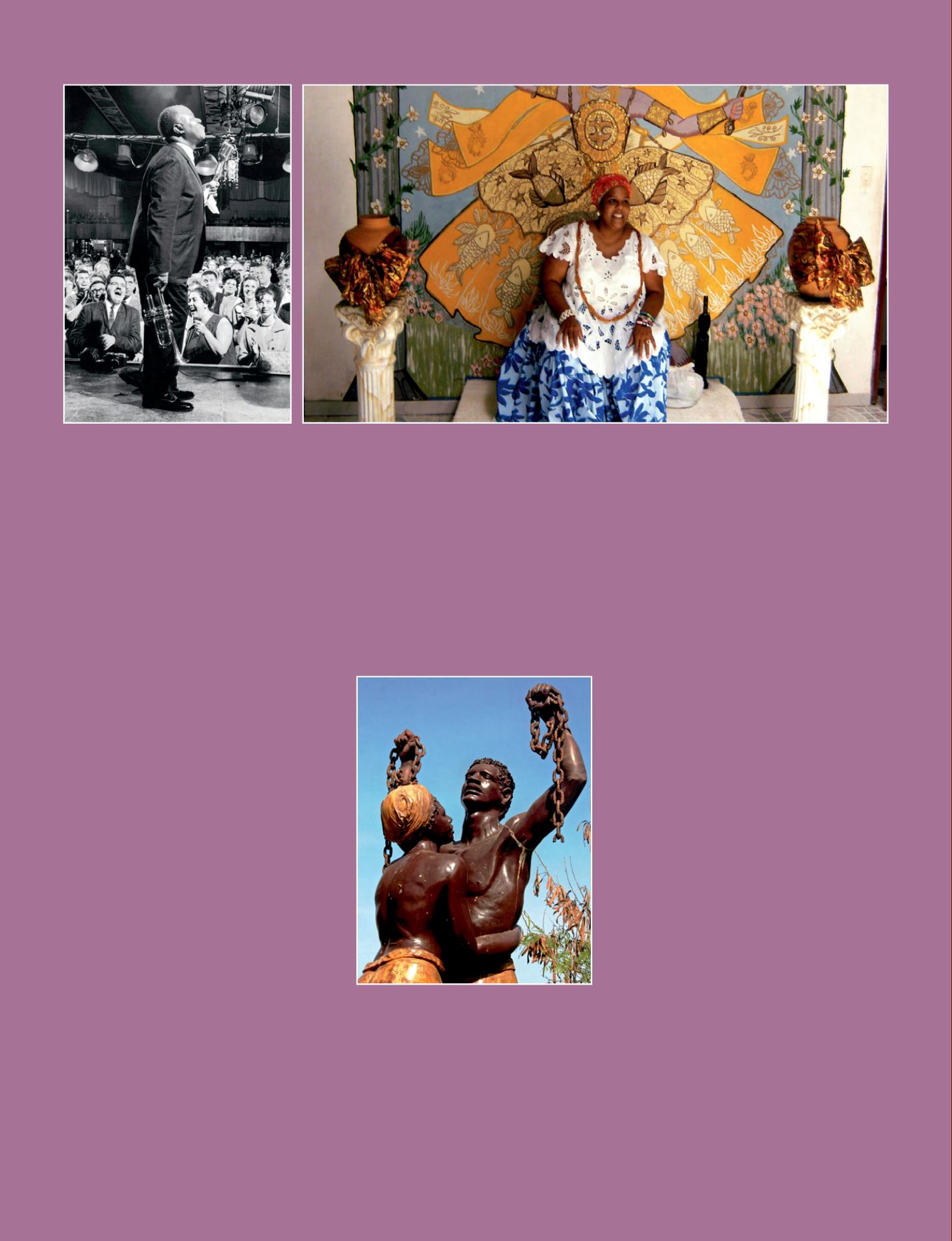
T
he intercontinental spread of African cultures took place
painfully via the development of the slave trade with the
Americas as the destination. From the 16th century onwards,
the Spanish and Portuguese colonisation of the New World
stimulated the plantation economy and mining. This resulted in
the systematic use of slavery and a massive
inflow of sub-Saharan labour from the Gulf of
Guinea. When the Amerindians disappeared
or were lacking, the authorities, allied with
the slave companies, replaced them by black
slaves who lived in even worse conditions
than the natives insofar as they had even
less of a legal framework that was supposed
to ‘protect’ them.
Although slavery was not officially abolished
until1886inCuba(aSpanishcolonyuntil1898)
and 1888 in Brazil, which alone imported 3
million slaves, an involuntary result of this
intolerable reality was a considerable human
and cultural enrichment.
Considerable interbreeding took place over
the centuries in both the Caribbean and Bra-
zil, making these areas a rich melting pot
with multiple expressions. We now find syn-
cretic religions of African origin, sometimes
flourishing strongly: Santería, also called Re-
gla de Ocha in Cuba, with Yoruba roots; Palo
Monte; Candomblé in Brazil, voodoo in Haiti
and so on. Official languages are dotted with hundreds of Afri-
can words. Oral traditions (stories, narratives and legends) are
passed on from one generation to the next and on the way feed
literature, the arts and a whole body of imagination and creation
that has not been reserved for the descendants of Africans alone:
along with the milk of the slave wet nurses, the white children
of rich colonial families fed on stories, ways of thinking and
different sensibilities. Deep-seated acculturation took place,
often unbeknown to all those involved.
African culture has had an undeniable effect in the liberation of
the peoples deported during colonisation. This is particularly
the case of music, used as an effective weapon in combating
racial segregation. The history of jazz tallies
with that of slavery in the United States and
also chants the struggles for the emancipa-
tion of Americans of African descent. Played
and liked all over the world, it popularised
the cause of oppressed people.
In a different political context, the various
musical styles of Brazil have been marked
by the music of several parts of Africa. The
samba and capoeira originated in Angolan
music. The styles in the Nordeste are a fusion
of music from Portugal and Africa, especially
Yoruba: maracatu, that originated in Recife,
and choro, a form of blues.
Because of its history fashioned by slavery
and forced labour in plantations and mines,
Peru has become over the centuries a uni-
verse of dance and music to which all the
cultural entities in the country have contri-
buted. Creole dances and music are found in
all regions and blacks created musical ins-
truments that participate in the national he-
ritage. The Caribbean area has the strongest
mark of African heritage, especially in music. With rhythms and
instrumental features from Nigeria, Benin and the Congo, the
rumba, the son, the cha-cha and the guaracha draw on heri-
tages and traditions, just like the song lyrics and references to
Africans cults.
c
P.L.N.
i
Musician Louis Armstrong (1901-1971) was
the first African American to host a nationally
broadcast radio show in the 1930s.
© John Loengard/Time Life Pictures/Getty Images
i
Candomblé adept in Salvador da Bahia (Brazil). Candomblé is an African-Brazilian religion practised chiefly
in Brazil by the ‘povo do santo’ (people of saint). It originated from the knowledge of African priests that were
transplanted to America during the slave trade.
© J.Coles
i
House of Slaves Memorial, Island of Gorée,
Senegal.
© Laurent Givernaud
From Africa to America
18 - Sustainable Development in Africa & Satellites


